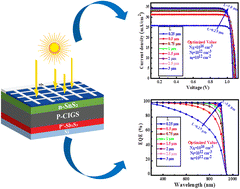Improving the efficiency of a CIGS solar cell to above 31% with Sb2S3 as a new BSF: a numerical simulation approach by SCAPS-1D
Abstract
The remarkable performance of copper indium gallium selenide (CIGS)-based double heterojunction (DH) photovoltaic cells is presented in this work. To increase all photovoltaic performance parameters, in this investigation, a novel solar cell structure (FTO/SnS2/CIGS/Sb2S3/Ni) is explored by utilizing the SCAPS-1D simulation software. Thicknesses of the buffer, absorber and back surface field (BSF) layers, acceptor density, defect density, capacitance–voltage (C–V), interface defect density, rates of generation and recombination, operating temperature, current density, and quantum efficiency have been investigated for the proposed solar devices with and without BSF. The presence of the BSF layer significantly influences the device's performance parameters including short-circuit current (Jsc), open-circuit voltage (Voc), fill factor (FF), and power conversion efficiency (PCE). After optimization, the simulation results of a conventional CIGS cell (FTO/SnS2/CIGS/Ni) have shown a PCE of 22.14% with Voc of 0.91 V, Jsc of 28.21 mA cm−2, and FF of 86.31. Conversely, the PCE is improved to 31.15% with Voc of 1.08 V, Jsc of 33.75 mA cm−2, and FF of 88.50 by introducing the Sb2S3 BSF in the structure of FTO/SnS2/CIGS/Sb2S3/Ni. These findings of the proposed CIGS-based double heterojunction (DH) solar cells offer an innovative method for realization of high-efficiency solar cells that are more promising than the previously reported traditional designs.



 Please wait while we load your content...
Please wait while we load your content...